By Owen Zammit — Analyst, and Dr. Maya Schushan Orgad — CTO & Principal
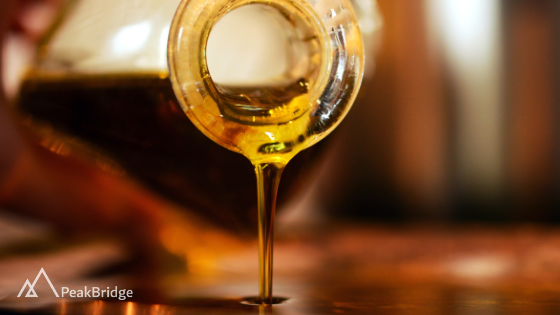
At PeakBridge, we are committed to learning more about FoodTech trends as they emerge. After being exposed to multiple startups trying to replace traditional fats, we decided to perform a deep dive on the space, to understand the current industry and its challenges, the technological approaches and the startup landscape thoroughly. This is the second instalment in the series — following on the keenly anticipated Mycelium here.
THE BASICS
What is fat?
The fatty acids group is one of the three key macronutrients humans need to survive — together with carbohydrates and protein. The generic term ‘fat’ or ‘oil’ typically refers to an assortment of triglycerides that are composed of two building blocks — glycerol and fatty acids. The type of fatty acid present will influence the classification of fat. In fact, all dietary fats can be divided into four types (figure 1, left-hand side):
- Saturated — have no double bonds.
- Mono-unsaturated — have 1 double bond in the fatty acid chain.
- Poly-unsaturated — have 2, or more double bonds in the fatty acid chain.
- Trans — a type of unsaturated fat having a trans arrangement of the carbon atoms adjacent to its double bonds.
The common solid fats and oils we are all familiar with, do not comprise of a single molecule or even type of fat. It is always a composition that consists of a mix of several fat types, as can be seen in the figure below (right-hand side).

Is it good or bad for you?
Well, actually both. Fat is essential in our diets since it serves many roles in the body including energy creation, absorption of key vitamins (A, D, E & K), insulation, and satiety. Moreover, some forms of essential fats, such as alpha-linolenic acid (Omega-3) and linoleic acid (Omega-6), cannot be produced by the body and need to be derived from food. However, excessive fat consumption leads to high cholesterol which is one of the risk factors for heart disorders — the major cause of global deaths (WHO, 2020). Figure 2 below displays the attributed health impact for different fatty acids, as well as the key sources for each fat type. The negative reputation of saturated fats is constantly being revisited, with a recent review showing no beneficial effect on cardiovascular health when their consumption is reduced.
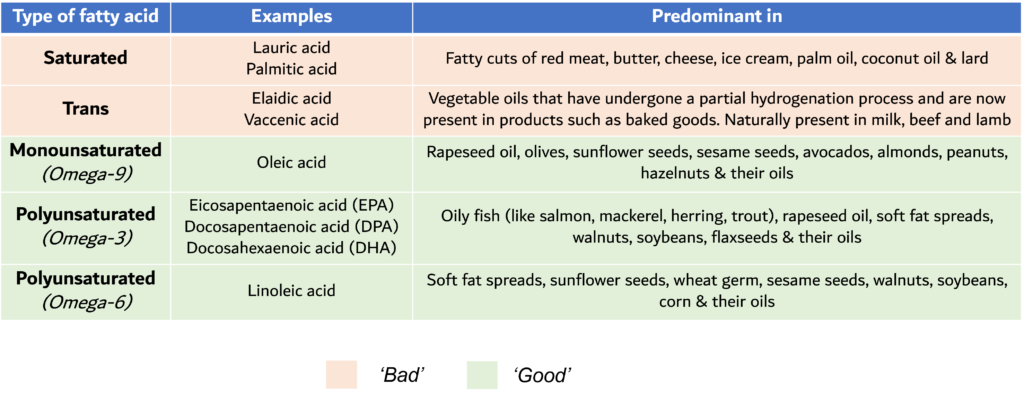
Fats vary in physical attributes
Fatty acid structure and composition affect its physical properties. All fats are insoluble in water (hydrophobic) due to their hydrocarbon structure which is non-polar. Yet, sources with a high composition of saturated fats, such as butter, tend to be solid at room temperature, whereas sources enriched with unsaturated fats, such as olive oil are usually liquid. Moreover, fats also differ in properties like melting point, smoking point and oxidative stability. These are influenced by one or more attributes of the fat composition including number of double bonds, chain length and saturation level.
FATS IN THE FOOD INDUSTRY
How are fats used in food?
Fat is key to the food industry due to its various applications, impacted by its varied functional properties. The table below summarises the key functions, respective applications and fat sources.
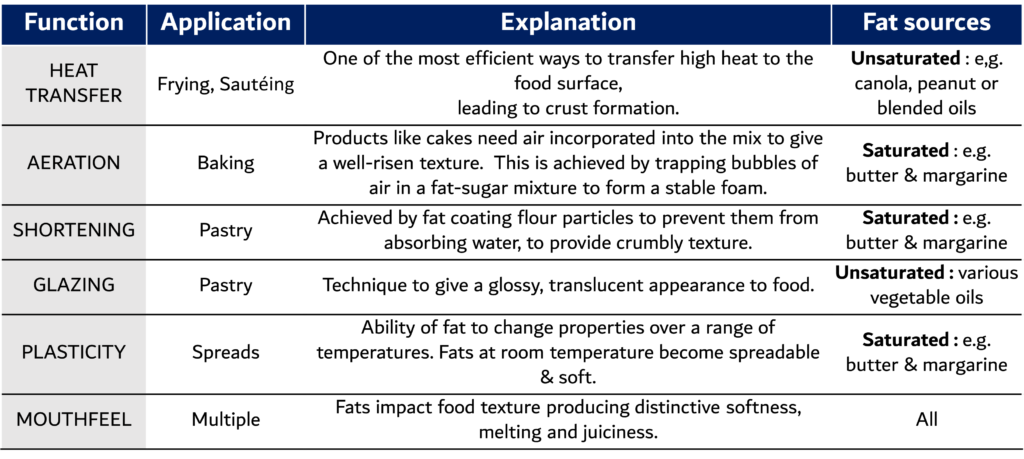
The market
In line with the various imperative applications mentioned above, the global market is a very large one, estimated at approximately 240 billion USD in 2021, and growing at a CAGR of 3.8%. The market is spread across solid fats, such as butter, lard and cocoa butter and oils, such as palm and soybean oil. Examples of key players include Cargill, Bunge, ADM and Kerry.
The rise of alternative fats
We mapped three main factors underlining the need for alternative fats, consisting of flavour and mouthfeel, health and sustainability issues. These can be further divided into issues with specific oils or fats, and application-driven challenges, which are not mutually exclusive. For specific oils, a prominent example is the highly abundant palm oil. Palm oil is used in numerous food applications including chocolate and ice cream, with an estimated market size of USD 42 bn. in sales in 2020. Palm oil is cheap, has great properties such as high smoking temperature and oxidative stability, yet is still high on saturated fats. However, huge concerns arise, owing to its health impact, as well as substantial sustainability issues including deforestation, threats to endangered species and an increase in child labour. All this is driving the search for viable alternatives. For more high-end fats such as cocoa butter and margarine, there is a rising need for healthier sustainable solutions, which possess the same functional attributes including taste and mouthfeel, at a similar or, hopefully, lower price point. From an application perspective, meat alternatives, dairy alternatives and chocolate are probably the most prominent ones. In these, the aspects of flavour, health and sustainability issues are further described in figure 4 below.
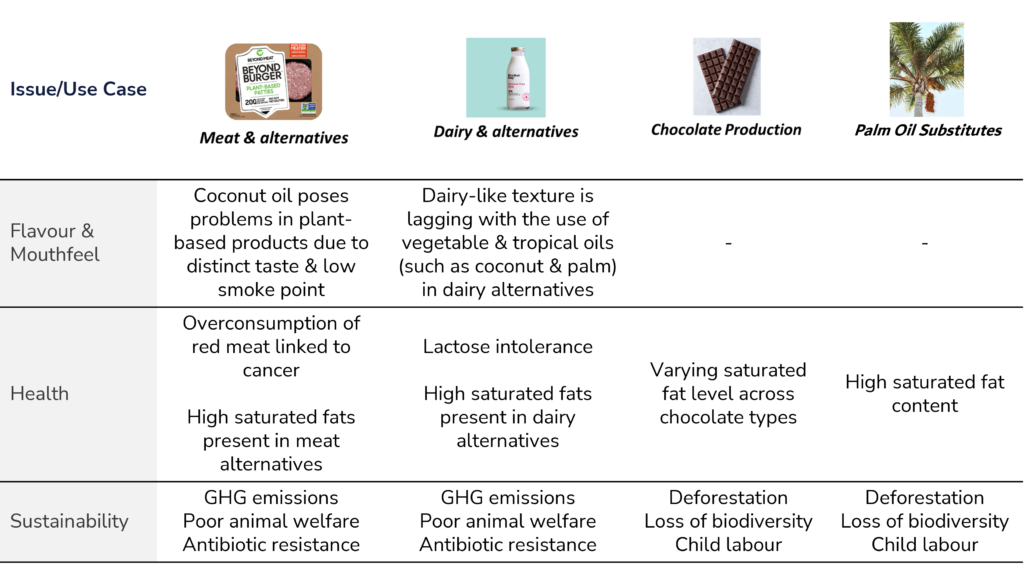
Which alternatives?
There are various approaches to producing alternative fats. The table below sums up the main ones, with an overview of each approach and a quick comparison. Next, we will be addressing the different approaches further.
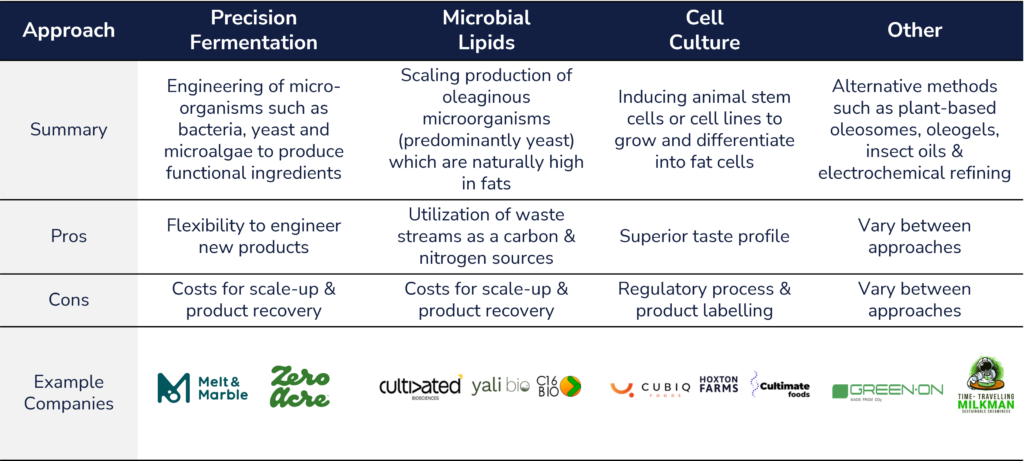
- Precision fermentation is a well-known approach, widely applied in the food industry. The concept always includes re-engineering microorganisms to teach them to produce novel molecules which are not naturally produced. The approach is applied in the same way to produce fat replacers. Applying precision fermentation requires understanding of the metabolic pathways underlining the fat molecules, in combination with strain engineering and the development of purification downstream processes to extract the fat molecules. Enzyme libraries, as well as metabolic models, are needed to accelerate strain engineering. The key advantage is the ability to fully control and manipulate microbe fat production, which enables great flexibility to tailor flavour profiles, resulting in a potential broad range of fat products. Drawbacks include the need to pass the products through regulation, as well as scale-up costs and COGs reduction to reach competitive pricing.
- Microbial lipids. These are fats derived from oleaginous microorganisms which are defined as producing more than 20% (w/w) of their dry cell weight as lipids. Some of the potential microorganisms that can be used as fat sources are microalgae, bacteria, and yeast. Lipid accumulation in oleaginous microorganisms is triggered by an excess of carbon source and limiting a nitrogen source. Lipid production capabilities vary across species — scientists can influence lipid production in various ways — mainly through the overexpression of lipid accumulation genes and knockout of lipid degradation genes. Single-cell oils are formed intracellularly so require extraction, which is a cost consideration during processing scale-up. Compared to precision fermentation, here the end fat product is essentially what the microorganism naturally produces — this has potentially regulatory advantages, yet leaves less room for impacting the product type, thus limiting product range. Moreover, as these are non-GMOs, there is limited capacity to influence the production efficiency at the strain and molecular levels.
- Cell cultured fat. The fat cell culture approach is a natural extension of the emerging cultured meat industry, incorporating part of the same technologies and methods used to develop alternative meat. The idea is to produce only one type of cell — namely the fat cells, to be used as a novel source of fat for alternative meat and potentially dairy applications. This requires first isolating stem cells or cell lines from animal sources and differentiating them into fat cells. As the cellular end-product contains natural animal fat — this approach produces a superior taste profile, which is of course an outcome of the original animal source of the cell line. Scale-up will require dealing with some of the challenges of the cultured meat industry, including cost of production of media components, CAPEX investments and down-stream process development, as well regulatory requirements and public acceptance issues.
- Other approaches. A number of other alternatives are under development as well. Examples include, but are not limited to, extraction of natural fat oleosomes from plant seeds, insect-derived oils, developing oleogel solutions (which are encapsulation approaches to existing oils to alter functionality), as well as chemical-based production. These approaches are extremely different in both the fat source, output fat product and aspects related to scale up, costs and regulation.
Going back to the challenges mentioned above regarding the meat, dairy and chocolate applications, we can summarize that, as usually happens, there is no silver-bullet solution that fits all. Specifically, precision fermentation has an advantage in the potential product range and thus might be a good solution for various applications. Yet, the path to market will be long, with substantial cost and regulatory hurdles. Cultured cells would probably be closest to the real thing and would be more suited to alternative meats. This approach will also likely face regulatory, scale-up, cost as well as public acceptance barriers. The natural based sources such as microbial or other types of naturally derived oils would probably reach the market fastest. Relying on the naturally derived oils, the resulting products might be an interesting solution, with most prominent application owing to their physical properties is alternative dairy.
THE CURRENT LANDSCAPE
Which are the companies doing it? A number of startups already dot the landscape across the different approaches, some of which were described in an article by FoodHack last year. We have compiled a map representing selected examples of these startups below. In contrast to the alternative meat and dairy spaces, however, fat replacers, which are an enabler of both markets, have received considerably less funding to date. According to a recent Sifted article, alternative fat startups in Europe received USD 101 m. in funding between 2015 and 2022. In comparison, alternative meat startups were able to raise USD 585 m. during the same time period.
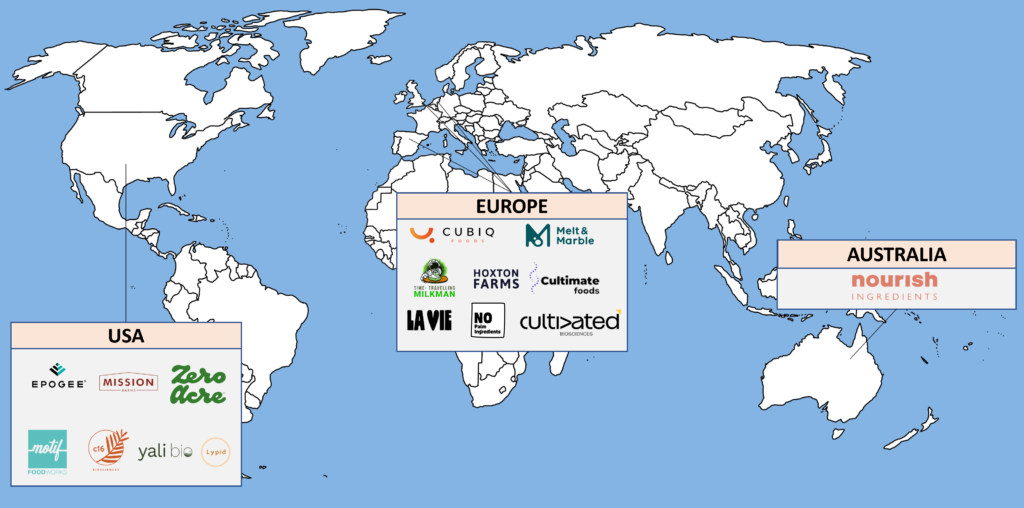
KEY TAKEAWAYS
The shift to plant-based alternatives is one of the key drivers for alternative fats since fats are imperative for taste, texture & mouthfeel. Another key motivation for the rise of alternative fats resides in problems with specific oils and fats, with the most prominent example being the health and sustainability of palm oil. However, despite the different technological approaches, there are a few bottlenecks to larger-scale adoption. These are mainly scalability, which influences cost, and regulatory approvals. This can be a great opportunity to ensure the taste of alternative fats is on a par with, if not better than, the real thing.
SELECTED FURTHER READING
- Abeln F, Chuck CJ. The history, state of the art and future prospects for oleaginous yeast research. Microbial Cell Factories. 2021 Dec 7;20(1):221.
- Astrup A, Magkos F, Bier DM, Brenna JT, de Oliveira Otto MC, Hill JO, et al. Saturated Fats and Health: A Reassessment and Proposal for Food-Based Recommendations: JACC State-of-the-Art Review. J Am Coll Cardiol. 2020 Aug 18;76(7):844–57.
- Fish KD, Rubio NR, Stout AJ, Yuen JSK, Kaplan DL. Prospects and challenges for cell-cultured fat as a novel food ingredient. Trends Food Sci Technol. 2020 Apr;98:53–67.
- Ghazani SM, Marangoni AG. Microbial lipids for foods. Trends in Food Science & Technology. 2022 Jan 1;119:593–607.
- Nikiforidis CV. Structure and functions of oleosomes (oil bodies). Advances in Colloid and Interface Science. 2019 Dec 1;274:102039.
- Scharfe M, Flöter E. Oleogelation: From Scientific Feasibility to Applicability in Food Products. European Journal of Lipid Science and Technology. 2020;122(12):2000213.
- Schiff-Deb, Celine. The oil & fat industry — ready for a shakeup? Available from https://www.linkedin.com/pulse/oil-fat-industry-ready-shakeup-celine-schiff-deb/
- Ochsenreither K, Glück C, Stressler T, Fischer L, Syldatk C. Production Strategies and Applications of Microbial Single Cell Oils. Frontiers in Microbiology [Internet]. 2016 [cited 2022 May 15];7. Available from: https://www.frontiersin.org/article/10.3389/fmicb.2016.01539
- Yuen Jr JSK, Stout AJ, Kawecki NS, Letcher SM, Theodossiou SK, Cohen JM, et al. Perspectives on scaling production of adipose tissue for food applications. Biomaterials. 2022 Jan 1;280:121273.
